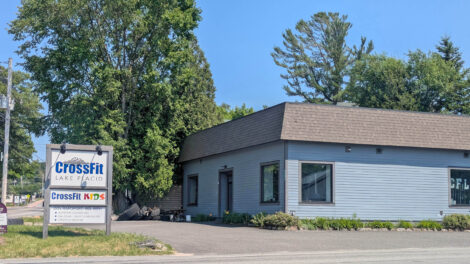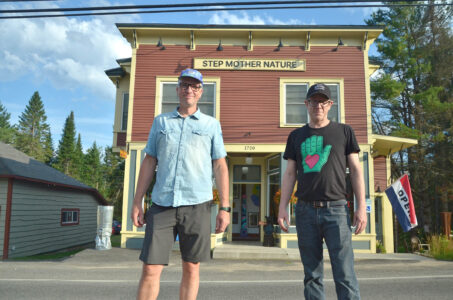New study: Salt disrupts Mirror Lake turnover

Mirror Lake in Lake Placid is seen here in March 2016. (Enterprise photo — Andy Flynn)
LAKE PLACID — Road salt runoff into Mirror Lake is derailing its natural mixing process and posing a threat to its lake trout population, a new study released this week shows.
The peer-reviewed study, co-authored by AuSable River Association Science and Stewardship Director Brendan Wiltse and Adirondack Watershed Institute researchers Elizabeth Yerger and Corey Laxson, shows that road salt and stormwater runoff has contributed to a discrepancy in water density between different layers of the lake. This discrepancy has disrupted the natural spring mixing cycle and created low-oxygen conditions that reduce the habitability of the lake for its lake trout population.
“This interruption in turnover is something that hasn’t been documented in scientific literature very much,” Wiltse said. “It’s a pretty significant finding, especially to have this occurring in the middle of the Adirondack Park, which was created to protect our water.”
—
Mixing disrupted
—
The study focuses on conditions in Mirror Lake between 2016 and 2017, when researchers observed “an apparent incomplete spring mixing in Mirror Lake.”
Mirror Lake is what’s called a “dimictic lake,” which means that its natural mixing process — when water cycles from its surface to the floor — happens twice per year, once in the spring and again in the fall. This process distributes oxygen to the deepest part of the lake, creating a habitat where lake trout can thrive.
Between December 2015 and January 2018, researchers sampled Mirror Lake’s water quality biweekly when it wasn’t frozen over, and monthly when it was. Water samples were taken to the Adirondack Watershed Institute at Paul Smith’s College for analysis. That analysis included determining chloride concentration. Chloride can signal road salt infiltration.
In 2016, researchers found the concentration of chloride at the bottom of the lake increased in the winter, as it does when salt is being applied to roads within the watershed. Chloride concentrations between the lake’s layers became uniform with the spring mixing process, and remained uniform throughout the summer as those layers stratified and took on different temperatures. But in 2017, a high concentration of chloride persisted in the deepest layer of the lake throughout the summer.
In both years, the chloride concentrations were uniform during the fall, when the lake went through its second yearly mixing cycle.
Wiltse said researchers are continuing to study Mirror Lake to this day. In the last two years, the lake has continued to see a disruption of its first mixing cycle.
—
Trout habitat ‘restricted’
—
The lack of mixing in the spring is bad news for the Mirror Lake’s rainbow and lake trout population.
According to the study, the lake trout habitat was “restricted” in 2016 and 2017 by a combination of warm surface water and low-oxygen conditions at the bottom spurred by high chloride concentration. Lake trout need cold, oxygenated water.
“The major thing is, because the lake doesn’t turn over in the spring anymore, not as much oxygen is being distributed to the bottom layer of the lake,” Wiltse said. “The water turns over in the fall still as it naturally would, but if that were to ever stop as well … there’s a good chance we could see winter fish kill in the lake.”
The lake trout population is already likely to decline due to a combination of narrow habitat requirements, slow growth and late sexual maturity, all of which “make lake trout particularly vulnerable to climate change,” according to the study.
“Mirror Lake has demonstrated a significant increase in the ice-free period over the past 114 years, with the lake currently experiencing an average of 24 more days being ice free than in the early 1900s,” the study reads. “Climate-driven effects on the lake trout population in Mirror Lake will be further exacerbated by the lack of complete mixing in the spring.”
Mirror Lake’s fish population includes smallmouth and rock bass, white sucker, pumpkinseed, yellow perch and brown bullhead. The state Department of Environmental Conservation regularly stocks the lake with rainbow and lake trout.
—
Potential for algae blooms
—
Low-oxygen conditions at the bottom of Mirror Lake also puts the lake at risk of developing algae blooms.
Prolonged low-oxygen periods can result in some chemical changes within the lake, Wiltse said, including the mobility of phosphorus.
“Phosphorus drives algae blooms,” he said. “Elevated levels of phosphorus, along with chloride, makes Mirror Lake more susceptible to algae blooms.”
Most algae blooms are harmless, according to the DEC. But people and pets can get sick when they’re exposed to toxins and other substances from what the department calls “harmful algae blooms.”
DEC spokeswoman Erica Ringewald said last year that HABs “are likely triggered by a combination of water and environmental conditions that may include excess nutrients (phosphorus and nitrogen), lots of sunlight, low-water or low-flow conditions, calm water and warm temperatures.”
—
Salt, stormwater reduction recommended
—
Mirror Lake’s spring mixing period could be restored if measures are taken to reduce road salt and stormwater runoff, the study says.
Twenty-two stormwater outfalls empty out into Mirror Lake, according to the study. They drain Main Street, a state road; as well as the village and town’s sidewalks, and private and public parking lots. A sampling of the outfalls during the winter “frequently yielded” chloride concentrations entering the lake between 2,500 to 12,500 times greater than runoff from the least-impacted streams in the Adirondack Park.
“This isn’t super precise because we don’t have road salt application data, but perhaps a 30-40% reduction in salt could result in mixing,” Wiltse said. “That’s really a ballpark estimate. We’re working with the town (of North Elba) and the village (of Lake Placid) to measure road salt application.”
The town and village are working on installing automated equipment on its snowplows that would measure how much salt is being dispensed, he said.
—
Ongoing efforts
—
Lawmakers have been exploring options for reducing road salt and stormwater runoff for years.
The state Department of Transportation conducted a pilot program on state Route 86, between Lake Placid and Wilmington, this past winter. The DOT lowered the speed limit, used new snowplow equipment and reduced road salt use for 16 miles between Old Military Road to just past the Whiteface Mountain Ski Center. The DOT did a similar pilot program along the same route in 2012-13, which lead to a 10% salt reduction statewide on the DOT’s part.
Last month, state Sen. Betty Little, R-Queensbury, joined assemblymen Dan Stec, R-Queensbury, and Billy Jones, D-Plattsburgh, in Saranac Lake to introduce the “Randy Preston Salt Reduction Act,” a piece of legislation the lawmakers intend to propose aimed at reducing road salt contamination. If adopted, the legislation would establish an Adirondack Road Salt Reducation Task Force and direct the DOT, DEC and state Department of Health to conduct a three-year salt application reduction pilot program on every state road in the Adirondack Park. The bill is named in honor of former Wilmington town Supervisor Randy Preston, who died in July. Preston called for the reduction of road salt use for years.
The town instituted a no-salt zone along their section of Mirror Lake Drive last year, and in 2016, the village attempted to use a salt and corn-starch based de-icer on sidewalks along their stretch of that road. That test was largely deemed a failure because rain diluted the mixture and the lack of sunlight in that area prevented a speedy melt.
The village is gradually moving toward a large-scale Main Street project intended to protect Mirror Lake, update drinking water infrastructure and reconstruct the streetscape. As part of the project, the village intends to update the stormwater system along the road and install bio-retention basins at the bottom of Saranac Avenue.




